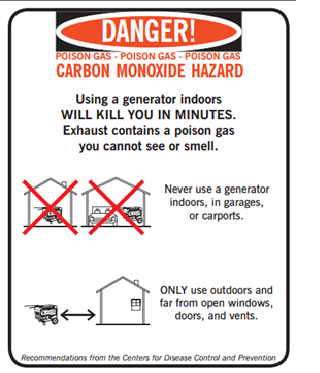Carbon Monoxide
Carbon Monoxide (CO) is a colorless, odorless gas that can be harmful or fatal when inhaled in closed spaces. CO is made by the burning of any fuel (including coal, gasoline, diesel, kerosene, or wood). Any combustion source (stoves, ovens, boilers, furnaces, portable generators, unvented kerosene and gas space heaters, leaking chimneys) will produce CO gas.
Carbon Monoxide Poisoning In Maryland
Inforation on CO poisoning in Maryland can be found on the Environmental Health data portal. The figure below shows the causes of unitentional carbon monoxide poisoning in Maryland in from 2010 - 2021.
![]()
Preventing Carbon Monoxide Poisoning
You can prevent carbon monoxide poisoning by installing a battery-operated (or plug-in with battery back-up) carbon monoxide (CO) detector in your home. Install the CO alarm in the hallway near the bedrooms in each separate sleeping area, and make sure the CO alarm is not covered up by furtniture or curtains. Test the CO alarm frequently and replace dead batteries. Learn more.
A CO alarm can provide added protection in the event that an appliance becomes a source of carbon monoxide. Fuel-burning appliances that are improperly used, malfunctioning, or not installed correctly can all become sources of carbon monoxide.
malfunctioning, or not installed correctly can all become sources of carbon monoxide.
- Make sure appliances are properly installed and operating with adequate ventilation.
- Install and use an exhaust fan vented to outdoors over gas stoves.
- Never leave a car running in a garage even with the door open.
- Never run a portable generator in the home, garage, shed, basement, or crawlspace. When running a generator outdoors, keep it away from open windows and doors. Learn more.
- Have appliances regularly serviced by a trained professional.
- Never bring a charcoal grill into the house or garage for heating or cooking.
Look for other clues that carbon monoxide may be entering your home:
- Rusting or water streaking on vent/chimney
- Loose or missing furnace panel
- Sooting
Debris or soot falling from chimney, fireplace,
or appliances
- Loose or disconnected vent/chimney, fireplace
or appliance
- Loose masonry on chimney
- Moisture inside of windows
Know the symptoms of carbon monoxide poisoning: headache, dizziness, weakness, nausea, vomiting, sleepiness, and confusion. If you suspect CO poisoning, get outside to fresh air immediately, and then call 911.
Carbon Monoxide and Boating
Large boats (such as house boats) sometimes have a generator that vent toward the rear of the boat. Individuals who are near the rear deck or water platform are at risk for carbon monoxide poisoning. Carbon monoxide can build up above the water, near the water platform, in the air space beneath the stern deck, or on and/or near the swim deck.
Traveling at slow speeds or idling in the water can cause carbon monoxide to build up in a boat’s cabin, cockpit, bridge, or in an open area.
Back drafting can cause carbon monoxide to build up inside the cabin, cockpit, and bridge when a boat is operated at a high bow angle, improperly or heavily loaded, or draws in exhaust form an opening. This build-up is extremely dangerous and can kill someone in seconds.
How To Prevent Carbon Monoxide Poisoning On Boats
- Install and properly maintain a carbon monoxide detector.
- Educate all passengers about the dangers of carbon monoxide poisoning.
- Swim and play away from areas where engines vent their exhaust.
- Never block exhaust outlets.
- Dock or anchor at least 20 feet away from nearest boat that is running. Exhaust form a nearby vessel can send carbon monoxide into your cabin/cockpit.

